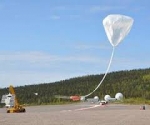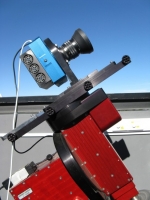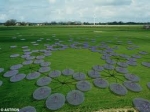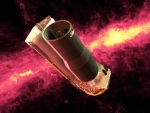Displaying items by tag: telescope
Sunrise (telescope)
The Sunrise project is a balloon-borne solar observatory. It consists of a 1m aperture Gregory telescope, a UV filter imager, an imaging vector polarimeter, an image stabilization system and further infrastructure.
The SUNRISE project aims at high-resolution spectro-polarimetric observations of the solar atmosphere on the intrinsic spatial scale of its magnetic structure. The SUNRISE telescope with 1 m aperture and its instruments will provide spectra and images resolving spatial scales down to 35 km on the Sun. The main scientific goal of the mission is to understand the formation of magnetic structures in the solar atmosphere and to study their interaction with the convective plasma flows. The first science flight of Sunrise yielded high-quality data that reveal the structure, dynamics and evolution of solar convection, oscillations and magnetic fields at a resolution of around 100 km in the quiet Sun.
IceCube Neutrino Observatory
The IceCube Neutrino Observatory (or simply IceCube) is a neutrino telescope constructed at the Amundsen-Scott South Pole Station in Antarctica.
Its thousands of sensors are distributed over a cubic kilometre of volume under the antarctic ice. Similar to its predecessor, the Antarctic Muon And Neutrino Detector Array (AMANDA), IceCube consists of spherical optical sensors called Digital Optical Modules (DOMs), each with a photomultiplier tube (PMT) and a single board data acquisition computer which sends digital data to the counting house on the surface above the array. IceCube was completed on 18 December 2010, New Zealand time.
DOMs are deployed on "strings" of sixty modules each at depths ranging from 1,450 to 2,450 meters, into holes melted in the ice using a hot water drill. IceCube is designed to look for point sources of neutrinos in the TeV range to explore the highest-energy astrophysical processes.
KELT-South telescope
The KELT-South telescope (Kilodegree Extremely Little Telescope - South) is a small robotic telescope that is designed to detect transiting extrasolar planets.
The telescope is owned and operated by Vanderbilt University and is based on the design of KELT-North, which was conceived and designed at the Ohio State University, Department of Astronomy.
The KELT-South telescope serves as a counterpart to its northern twin, surveying the southern sky for transiting planets over the next few years.
SKA project
The Square Kilometre Array (SKA project) is a multi-purpose radio telescope that will play a major role in answering key questions in modern astrophysics and cosmology.
It will be one of a small number of cornerstone observatories around the world that will provide astrophysicists and cosmologists with a transformational view of the Universe. It will allow investigating galaxy evolution, cosmology and dark energy.
The Square Kilometre Array will provide a million square metres of collecting area. This huge increase in scale demands a revolutionary break from traditional radio telescope design.
The Square Kilometre Array will be the world's largest and most sensitive radio telescope.
Thousands of linked radio wave receptors will be located in Australia and in Southern Africa. Combining the signals from the antennas in each region will create a telescope with a collecting area equivalent to a dish with an area of about one square kilometre.

The SKA will address fundamental unanswered questions about our Universe including how the first stars and galaxies formed after the Big Bang, how galaxies have evolved since then, the role of magnetism in the cosmos, the nature of gravity, and the search for life beyond Earth.
The Square Kilometre Array is a global science and engineering project led by the SKA Organisation, a not-for-profit company with its headquarters at Jodrell Bank Observatory, near Manchester, UK.
An array of dish receptors will extend into eight African countries from a central core region in the Karoo desert of South Africa. A further array of mid frequency aperture arrays will also be built in the Karoo. A smaller array of dish receptors and an array of low frequency aperture arrays will be located in the Murchison Radio-astronomy Observatory in Western Australia.
- The SKA will be so sensitive that it will be able to detect an airport radar on a planet 50 light years away.
- The SKA central computer will have the processing power of about one hundred million PCs.
ESO, European Southern Observatory
European Southern Observatory, is the foremost intergovernmental astronomy organisation in Europe and the world's most productive astronomical observatory. ESO provides state-of-the-art research facilities to astronomers and is supported by Austria, Belgium, the Czech Republic, Denmark, Finland, France, Germany, Ireland, Italy, the Netherlands, Poland, Portugal, Spain, Sweden, Switzerland and the United Kingdom, along with the host state of Chile. Several other countries have expressed an interest in membership.
ESO, formally the European Organisation for Astronomical Research in the Southern Hemisphere, is usually known as The European Southern Observatory.
ESO's main mission, laid down in the 1962 Convention, is to provide state-of-the-art research facilities to astronomers and astrophysicists, allowing them to conduct front-line science in the best conditions. The annual Member State contributions to ESO are approximately 198 million euros and ESO employs around 700 staff members. By building and operating a suite of the world's most powerful ground-based astronomical telescopes enabling important scientific discoveries, ESO offers numerous possibilities for technology spin-off and transfer, together with high technology contract opportunities and is a dramatic showcase for European industry.
The ESO Headquarters (comprising the scientific, technical and administrative centre of the organisation) are located in Garching near Munich, Germany. In Chile, ESO operates the Vitacura centre as well as three unique observing sites: La Silla, Paranal and Chajnantor.
ESO is building the 39-metre Extremely Large Telescope, the ELT, which will become “the world’s biggest eye on the sky”.
SOLIS
Synoptic Optical Long-term Investigations of the Sun (SOLIS) is a new synoptic facility for solar observations over a long time frame that is funded by the National Science Foundation (NSF) and designed and built by the National Solar Observatory (NSO).
SOLIS will provide unique observations of the Sun on a continuing basis for several decades to understand the solar activity cycle, sudden energy releases in the solar atmosphere, and solar irradiance changes and their relationship to global change.
SOLIS is composed of a single equatorial mount (right) carrying three telescopes. The first system is located on top of the Kitt Peak Vacuum Telescope building (left), and the NSO Long Range Plan calls for a global network of two more VSMs to enable continuous solar observations.
LOFAR
LOFAR is a very large connected radio telescope, using a new concept based on a vast array of omni-directional antennas.
LOFAR is a Low-Frequency Array for radio astronomy, built by ASTRON, the Netherlands Institute for Radio Astronomy and operated by ASTRON's radio observatory. ASTRON is part of the Netherlands Organisation for Scientific Research.
The project is based on an interferometric array of radio telescopes using about 25,000 small antennas concentrated in at least 48 larger stations. 40 of these stations are distributed across the Netherlands, five stations in Germany, and one each in Great Britain, France and Sweden. Further stations may also be built in other European countries. The total effective collecting area is up to approximately 300,000 square meter, depending on frequency and antenna configuration. The data processing is performed by a Blue Gene/P supercomputer situated in the Netherlands at the University of Groningen. LOFAR is also a pathfinder for the Square Kilometre Array. The Square Kilometre Array will be the world's largest and most sensitive radio telescope. The SKA will be built in Southern Africa and in Australia.
It is a global enterprise bringing together 11 countries from the 5 continents.
Faulkes Telescope Project
The Faulkes Telescope Project (FTP) is supported by the Dill Faulkes Educational Trust. It provides access to 1,500 hours of observing time on two 2-metre class telescopes located in Hawaii (Faulkes Telescope North in Hawaii) and Australia (Faulkes Telescope South in Australia). This time is dedicated to education and public outreach, mainly in the UK, but also for smaller, selected projects in Europe and the US.
FTP has operated a UK-wide educational programme since 2004, and currently works with science education projects across Europe and further afield (e.g. USA, Russia, Israel), including many EU-based science, maths and ICT programmes. FTP specialises in providing physics and maths education and outreach via astronomy and space science, utilising the unique access it can provide to research-grade facilities. The basic philosophy is to engage learners in “real science”, making them active participants in a range of astronomical research projects, ranging from observations of the solar system to distant galaxies. Teacher training (both face-to-face and online) is a core component of the FTP educational philosophy, and project staff have been involved in professional development work both in the UK and overseas, with teacher training days being held in Moscow, Santa Barbara, Munich, Lisbon, Paris and several other venues in Portugal and Spain.
FTP operates a broad range of educational programmes, with a strong emphasis on teacher training and engaging students with “real science”. A variety of research projects are currently being run on the FTs, with schools often participating in the role of data gatherers, particularly in long-term monitoring or short-term intensive studies or Target of Opportunity requests for transient objects (e.g. GRBs, supernovae, NEOs or X-ray systems in outburst).
The project also provides extensive educational materials which can be accessed and downloaded free of charge from their educational resources website. These resources include astronomy video tutorials, online astronomy training, paper-based documents for use in the classroom, and pre-packaged data from the telescopes to use with the exercises detailed online.
Wide-field Infrared Survey Explorer (WISE)
Wide-field Infrared Survey Explorer (WISE) is a NASA infrared-wavelength astronomical space telescope launched on December 14, 2009, and decommissioned/hibernated on February 17, 2011 when its transmitter was turned off.
WISE was an Earth-orbiting satellite with a 40 cm (16 in) diameter infrared telescope, which performed an all-sky astronomical survey with images in 3.4, 4.6, 12 and 22 μm wavelength range bands, over 10 months. The initial mission length was limited by its hydrogen coolant, but a secondary post-cryogenic mission continued for four more months.
Spitzer Space Telescope
The Spitzer Space Telescope, formerly named as the Space Infrared Telescope Facility (SIRTF), is an infrared space observatory launched in 2003. It is the fourth and final of the NASA Great Observatories program.
The planned mission period was to be 2.5 years with a pre-launch expectation that the mission could extend to five or slightly more years until the onboard liquid helium supply was exhausted. This occurred on 15 May 2009. Without liquid helium to cool the telescope to the very cold temperatures needed to operate, most instruments are no longer usable. However, the two shortest wavelength modules of the IRAC camera are still operable with the same sensitivity as before thecryogen was exhausted, and will continue to be used in the Spitzer Warm Mission.
It follows a rather unusual orbit, heliocentric instead of geocentric, trailing and drifting away from Earth's orbit at approximately 0.1 astronomical unit per year (a so-called "earth-trailing" orbit). The primary mirror is 85 centimetres (33 in) in diameter, f/12 and made of beryllium and was cooled to 5.5 K (−449.77 °F). The satellite contains three instruments that allowed it to perform astronomical imaging and photometry from 3 to 180 micrometers, spectroscopy from 5 to 40 micrometers, and spectrophotometry from 5 to 100 micrometers.










